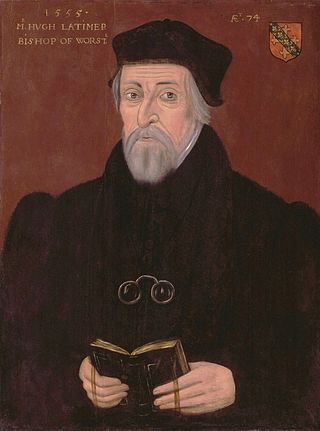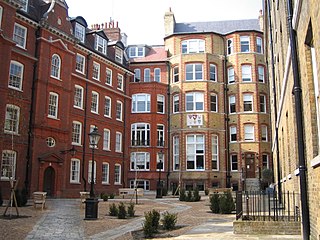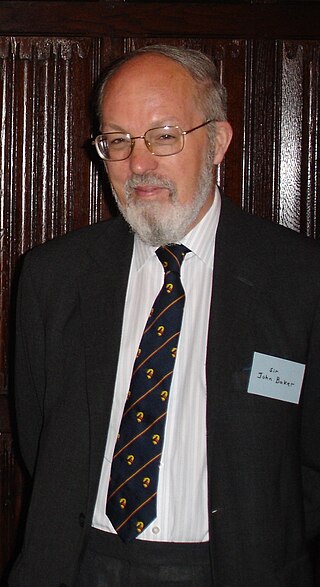Related Research Articles

The Honourable Society of the Middle Temple, commonly known simply as Middle Temple, is one of the four Inns of Court exclusively entitled to call their members to the English Bar as barristers, the others being the Inner Temple, Gray's Inn and Lincoln's Inn. It is located in the wider Temple area of London, near the Royal Courts of Justice, and within the City of London. As a liberty, it functions largely as an independent local government authority.

Hugh Latimer was a Fellow of Clare College, Cambridge, and Bishop of Worcester during the Reformation, and later Church of England chaplain to King Edward VI. In 1555 under the Catholic Queen Mary I he was burned at the stake, becoming one of the three Oxford Martyrs of Anglicanism.

The Honourable Society of the Inner Temple, commonly known as the Inner Temple, is one of the four Inns of Court and is a professional association for barristers and judges. To be called to the Bar and practise as a barrister in England and Wales, a person must belong to one of these Inns. It is located in the wider Temple area, near the Royal Courts of Justice, and within the City of London. As a liberty, it functions largely as an independent local government authority.

The Inns of Court in London are the professional associations for barristers in England and Wales. There are four Inns of Court – Gray's Inn, Lincoln's Inn, Inner Temple and Middle Temple.

Wirksworth is a market town in the Derbyshire Dales district of Derbyshire, England. Its population of 4,904 in the 2011 census was estimated at 5,180 in 2019. Wirksworth contains the source of the River Ecclesbourne. The town was granted a market charter by Edward I in 1306 and still holds a market on Tuesdays in the Memorial Gardens. The parish church of St Mary's is thought to date from 653. The town developed as a centre for lead mining and stone quarrying. Many lead mines were owned by the Gell family of nearby Hopton Hall.
John Bell was a Bishop of Worcester (1539–1543), who served during the reign of Henry VIII of England.

The Temple is an area of London surrounding Temple Church. It is one of the main legal districts in London and a notable centre for English law, historically and in the present day. It consists of the Inner Temple and the Middle Temple, which are two of the four Inns of Court and act as local authorities in place of the City of London Corporation as to almost all structures and functions.

The Inns of Chancery or Hospida Cancellarie were a group of buildings and legal institutions in London initially attached to the Inns of Court and used as offices for the clerks of chancery, from which they drew their name. Existing from at least 1344, the Inns gradually changed their purpose, and became both the offices and accommodation for solicitors and a place of initial training for barristers.

Sir Clement Higham, or Heigham, of Barrow, Suffolk, was an English lawyer and politician, a Speaker of the House of Commons in 1554, and Chief Baron of the Exchequer in 1558–1559. A loyal Roman Catholic, he held various offices and commissions under Queen Mary, and was knighted in 1555 by King Philip, but withdrew from politics after the succession of Queen Elizabeth I in 1558.

Sir John Hamilton Baker, KC (Hon), LLD, FBA, FRHistS is an English legal historian. He was Downing Professor of the Laws of England at the University of Cambridge from 1998 to 2011.
Francis Ludlow Holt was a legal and dramatic author.
Sir Anthony Browne QS (1509–1567), sometimes referred to as Antony Browne, was a British justice.
Sir Robert Rede KS was an English Chief Justice of the Common Pleas.

Admiral John Gell (1740–1806) was from the Gell and Eyre families of Hopton Hall in Derbyshire. He served with the Royal Navy, fighting in India and taking part in the occupation of Toulon.
Anthony Draycot was an English Roman Catholic churchman and lawyer. During the reign of Queen Mary he held a diocesan position as chancellor; his role in condemning numerous Protestants to death is detailed in Foxe's Book of Martyrs.

The Outer Temple is a building next to the Temple in London, just outside the City of London. In the 14th century, the property seized from the Knights Templar was divided, and that part of the Temple property then just outside London was given the name Outer Temple. It has been suggested that the name Outer Temple once also referred to an Inn of Chancery; its historical existence was first posited by A. W. B. Simpson and confirmed by John Baker in 2008. Little is known of it, other than that it lacked a hall; Baker suggests that this is the reason that it did not survive long enough to appear in many records. Other writers have insisted that it was never an inn: Sir George Buck wrote in 1612 "the Utter Temple neither is nor was ever any college or society of students".
William Latymer or Latimer (1499–1583) was an English evangelical clergyman, Dean of Peterborough from 1560. He was chaplain to Anne Boleyn, and is best known for his biography of her, the Chronickille of Anne Bulleyne.

St Mary the Virgin is a parish church in the Church of England in Wirksworth, Derbyshire. It is a Grade I listed building. The existing building dates mostly from the 13th–15th centuries, but notable survivals from the Anglo-Saxon period indicate a church has stood on this site since at least the 8th century AD. It was restored in 1820, then in 1870 by Sir Gilbert Scott.
The Royal Commission on the Inns of Court carried out an investigation into the Inns of Court and associated Inns of Chancery between 1854 and 1855. The inns were medieval guild-like institutions that provided accommodation for lawyers and had developed gradually into centres for legal education. All barristers in the country had to be a member of one of the inns. It included many of the leading lawyers and jurists of the time. The commission found many of the inns, particularly the Inns of Chancery, were ineffective at educating students and recommended the creation of a single university of law. Steps were taken to accomplish this and a parliamentary bill was prepared but it was never achieved. The commission did, however, have an influence on legal education for decades and was a factor in the establishment of modern law schools at the universities of Cambridge, Oxford and London.
The New Inn was one of the Inns of Chancery or Hospida Cancellarie. It existed from the late 15th century until 1902 and was located near Aldwych in London.
References
- ↑ Jonathan McGovern, 'Newly Discovered Notes of a Sermon by Hugh Latimer', The Journal of Ecclesiastical History 71, no. 3 (2020), 596–601
- 1 2 3 4 5 J.H. Baker, "Gell, Anthony (d. 1583)", Oxford DNB Online.